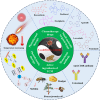Combinational Antitumor Strategies Based on the Active Ingredients of Toad Skin and Toad Venom
- PMID: 39139676
- PMCID: PMC11321342
- DOI: 10.2147/DDDT.S469832
Combinational Antitumor Strategies Based on the Active Ingredients of Toad Skin and Toad Venom
Abstract
A multidrug combination strategy is an important mean to improve the treatment of cancer and is the mainstream scheme of clinical cancer treatment. The active ingredients of traditional Chinese medicine, represented by toad skin and toad venom, have the advantages of high efficiency, low toxicity, wide action and multiple targets and have become ideal targets in combined treatment strategies for tumors in recent years. Toad skin and toad venom are traditional Chinese animal medicines derived from Bufo bufo gargarizans Cantor or Bufo melanostictus Schneider that have shown excellent therapeutic effects on the treatment of various cancers and cancer pain as adjuvant antitumor drugs in clinical practice. The involved mechanisms include inducing apoptosis, arresting the cell cycle, inhibiting cell proliferation, migration and invasion, inhibiting tumor angiogenesis, reversing the multidrug resistance of tumor cells, and regulating multiple signaling pathways and targets. Moreover, a multidrug combination strategy based on a nanodelivery system can realize the precise loading of the active ingredients of toad skin or toad venom and other antitumor drugs and carry drugs to overcome physiological and pathological barriers, complete efficient enrichment in tumor tissues, and achieve targeted delivery to tumor cells and the controlled release of drugs, thus enhancing antitumor efficacy and reducing toxicity and side effects. This article reviewed the clinical efficacy and safety of the combination of toad skin and toad venom with chemotherapeutic drugs, targeted drugs, analgesics and other drugs; evaluated the effects and mechanisms of the combination of toad skin and toad venom with chemotherapy, targeted therapy, radiotherapy or hyperthermia, traditional Chinese medicine, signaling pathway inhibitors and other therapies in cell and animal models; and summarized the codelivery strategies for the active ingredients of toad skin and toad venom with chemotherapeutic drugs, small-molecule targeted drugs, monoclonal antibodies, active ingredients of traditional Chinese medicine, and photodynamic and photothermal therapeutic drugs to provide a basis for the rational drug use of toad skin and toad venom in the clinic and the development of novel drug delivery systems.
Keywords: cancer; cancer pain; codelivery strategies; combinational antitumor strategies; toad skin; toad venom.
© 2024 Tian et al.
Conflict of interest statement
The authors declare no competing interests.
Figures







References
Publication types
MeSH terms
Substances
LinkOut - more resources
Full Text Sources

